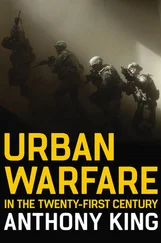Robert Forczyk - Tank Warfare on the Eastern Front, 1943-1945 - Red Steamroller
Здесь есть возможность читать онлайн «Robert Forczyk - Tank Warfare on the Eastern Front, 1943-1945 - Red Steamroller» весь текст электронной книги совершенно бесплатно (целиком полную версию без сокращений). В некоторых случаях можно слушать аудио, скачать через торрент в формате fb2 и присутствует краткое содержание. Город: Barnsley, Год выпуска: 2016, ISBN: 2016, Издательство: Pen and Sword, Жанр: military_history, на английском языке. Описание произведения, (предисловие) а так же отзывы посетителей доступны на портале библиотеки ЛибКат.
- Название:Tank Warfare on the Eastern Front, 1943-1945: Red Steamroller
- Автор:
- Издательство:Pen and Sword
- Жанр:
- Год:2016
- Город:Barnsley
- ISBN:978-1-78346-278-0
- Рейтинг книги:3 / 5. Голосов: 1
-
Избранное:Добавить в избранное
- Отзывы:
-
Ваша оценка:
- 60
- 1
- 2
- 3
- 4
- 5
Tank Warfare on the Eastern Front, 1943-1945: Red Steamroller: краткое содержание, описание и аннотация
Предлагаем к чтению аннотацию, описание, краткое содержание или предисловие (зависит от того, что написал сам автор книги «Tank Warfare on the Eastern Front, 1943-1945: Red Steamroller»). Если вы не нашли необходимую информацию о книге — напишите в комментариях, мы постараемся отыскать её.
Thereafter the war on the Eastern Front was dominated by tank-led offensives and, as Robert Forczyk shows, the Red Army’s mechanized forces gained the upper hand, delivering a sequence of powerful blows that shattered one German defensive line after another.
His incisive study offers fresh insight into how the two most powerful mechanized armies of the Second World War developed their tank tactics and weaponry during this period of growing Soviet dominance. He uses German, Russian and English sources to provide the first comprehensive overview and analysis of armored warfare from the German and Soviet perspectives. This major study of the greatest tank war in history is compelling reading.
Tank Warfare on the Eastern Front, 1943-1945: Red Steamroller — читать онлайн бесплатно полную книгу (весь текст) целиком
Ниже представлен текст книги, разбитый по страницам. Система сохранения места последней прочитанной страницы, позволяет с удобством читать онлайн бесплатно книгу «Tank Warfare on the Eastern Front, 1943-1945: Red Steamroller», без необходимости каждый раз заново искать на чём Вы остановились. Поставьте закладку, и сможете в любой момент перейти на страницу, на которой закончили чтение.
Интервал:
Закладка:
○ 3rd Guards Tank Corps (General-major Ivan A. Vovchenko)
○ 29th Tank Corps (General-major Evgeny I. Fominykh)
○ 3rd Guards Cavalry Corps (General-leytenant Nikolai S. Oslikovskiy)
○ Front Reserve:
○ 3rd Guards Mechanized Corps (General-leytenant Viktor T. Obukhov)
2nd Byelorussian Front (General-polkovnik Georgiy F. Zakharov)
• 4x Tank Brigades (23 G, 42 G, 43 G; 256)
• 1x Tank Regiment (233)
• 7x SAP (722, 1196, 1197, 1444, 1819, 1830, 1902)
1st Byelorussian Front (Marshal Konstantin K. Rokossovsky)
○ 2x Tank Brigades (1, 68)
○ 8x Tank Regiments (36, 42, 193, 223, 230, 231, 251, 259)
○ 16x SAP (713, 922, 925, 1204, 1205, 1206, 1221, 1295, 1812, 1821, 1888, 1890, 1897, 1899, 1900, 1901)
○ 3rd Army (General-leytenant Aleksandr V. Gorbatov)
○ 9th Tank Corps (General-major Boris S. Bakharov)
○ 65th Army (General-leytenant Pavel I. Batov)
○ 1st Guards Tank Corps (General-major Mikhail F. Panov)
○ 1st Mechanized Corps (General-leytenant Semyon M. Krivoshein)
Under Front control:
○ 8th Guards Tank Corps (General-leytenant Aleksei F. Popov)
○ 11th Tank Corps (General-major Filipp N. Rudkin)
○ 2nd Guards Cavalry Corps (General-leytenant Vladimir V. Kriukov)
○ 4th Guards Cavalry Corps (General-leytenant Issa A. Pliyev)
○ 7th Guards Cavalry Corps (General-major Mikhail P. Konstantinov)
1st Ukrainian Front (General Konstantin K. Rokossovsky)
• 1st Guards Tank Army
○ 8th Guards Mechanized Corps (General-major Ivan F. Dremov)
○ 11th Guards Tank Corps (General-leytenant Andrei L. Getman)
○ 64th Guards Tank Brigade
○ 11th Guards Tank Regiment
• 3rd Guards Tank Army
○ 6th Guards Tank Corps (General-major Vasily V. Novikov)
○ 7th Guards Tank Corps (General-major Sergei A. Ivanov)
○ 9th Mechanized Corps (General-leytenant Ivan P. Sukhov)
○ 91st Tank Brigade
○ 71st Guards Tank Regiment
• 4th Tank Army
○ 6th Guards Mechanized Corps (General-leytenant Aleksandr I. Akimov)
○ 10th Guards Tank Corps (General-major Evtikhii E. Belov)
○ 93rd Tank Brigade
○ 72nd Guards Tank Regiment
• 13th Army
○ 25th Tank Corps (General-major Fedor G. Anikushkin)
• 60th Army
○ 4th Guards Tank Corps (General-leytenant Pavel P. Poluboiarov)
○ 59th Tank Regiment
• 31st Tank Corps (General-major Vasily E. Grigoriev)
• 1x Tank brigade (150)
• 3x Tank Regiments (1G, 12 G; 39)
• 4x SAP (293 G; 1228, 1827, 1889)
2nd Ukrainian Front (General Rodion Ia. Malinovsky)
• 2nd Tank Army
○ 3rd Tank Corps (General-leytenant Vasily A. Mishulin)
○ 16th Tank Corps (General-major Ivan V. Dubovoi)
○ 11th Guards Tank Brigade
○ 754th, 1219th SAP
• 6th Tank Army (General-leytenant Andrei G. Kravchenko)
○ 5th Mechanized Corps (General-leytenant Mikhail V. Volkov)
○ 5th Guards Tank Corps (General-leytenant Vasily M. Alekseev) {3}
○ 156th Tank Regiment
○ 1494th SAP
• Under Front Control:
○ 7th Mechanized Corps (General-major Fedor G. Katkov)
○ 18th Tank Corps (General-major Vasily I. Polozkov) {4}
• 1x Tank Brigade (27 G)
• 2x Tank Regiments (25, 38)
3rd Ukrainian Front (General Fedor I. Tolbukhin)
• Under Front Control:
○ 4th Guards Mechanized Corps (General-major Vladimir I. Zhdanov)
○ 23rd Tank Corps (General-major Aleksei O. Akhmanov)
○ 5th Guards Mechanized Brigade
• 1x Tank Brigade (96)
• 2x Tank Regiments (5 G; 52)
• 6x SAP (398 G; 864, 1200, 1201, 1202, 1891)
STAVKA Reserve (RVGK)
• 10th Tank Corps (General-major Matvei K. Shaposhnikov)
• 19th Tank Corps (General-leytenant Ivan D. Vasiliev)
• 20th Tank Corps (General-leytenant Ivan G. Lazarev)
• 1st Guards Mechanized Corps (General-leytenant Ivan N. Russiyanov)
• 2nd Guards Mechanized Corps (General-leytenant Karp V. Sviridov)
• 5th Guards Mechanized Corps (General-major Boris M. Skvortsov)
• 7th Guards Mechanized Corps (General-leytenant Ivan P. Korchagin)
• 8th Mechanized Corps (General-major Abram M. Hasin)
Coastal Army (General-leytenant Kondrat S. Mel’nik)
• 1x Tank Brigade (63)
• 3x Tank Regiments (85, 244), 257)
• 1x SAP (1449)
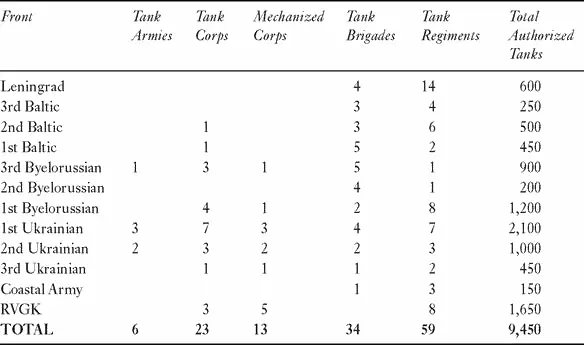
Reinforcements:
December:
• 10th Mechanized Corps
Appendix VI
Tank Production, 1944
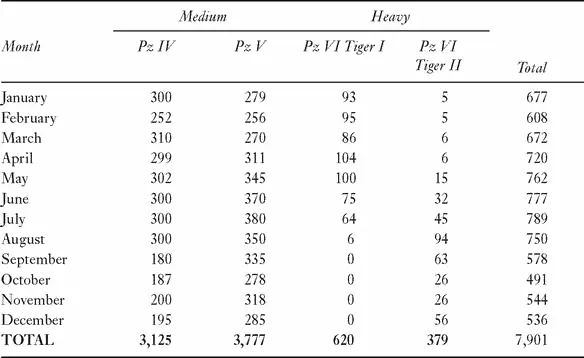
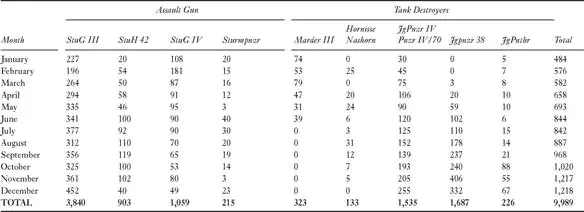
Key Industrial Decisions, 1944
• December 1943 – January 1944, Utilize Czech production facilities to mass-produce the Jagdpanzer 38 tank destroyer.
• Spring 1944, VOMAG ceases Pz IV production in favor of Jagdpanzer IV. Only Nibelungenwerke still producing Pz IV.
• August 1944, Hitler order Pz IV tank production to cease by the end of 1944 and shift production resources to the Jagdpanzer IV program.
Additional AFV Manufacturing Centers: Jagdpanzer 38 (t)
• Prague, Boemisch-Märische Maschinenfabrik (BMM), began production in March 1944
• Pilsen, Skoda Werke, began roduction in July 1944
New tank models (1):
• March 1944, Panther Ausf G introduced.
New assault gun models (1):
• August 1944, the Sturmtiger entered limited service (18 built) after a long development period by Krupp and Alkett. It mounted a 380-mm rocket launcher on a Tiger I hull.
New tank destroyer models (5):
• January 1944, the Jagdpanzer IV was introduced. It mounted a 7.5-cm Pak 39 L/48 atop a Pz IV chassis.
• January 1944, the Jagdpanther entered service, mounting an 8.8-cm Pak 43 on a Panther hull.
• April 1944, the Jagdpanzer 38 was introduced as a low-cost supplement to use the Pz 38(t) chassis with a 7.5-cm Pak 39 L/48.
• July 1944, the Jagdtiger is introduced in limited numbers, mounting a 12.8-cm Pak 44 L/55 atop a King Tiger chassis. Total of 51 built in 1944.
• August 1944, the Panzer IV/70, which was an up-gunned variant of the Jagdpanzer IV armed with the 7.5-cm Pak 42 L/70 gun, entered serviced.
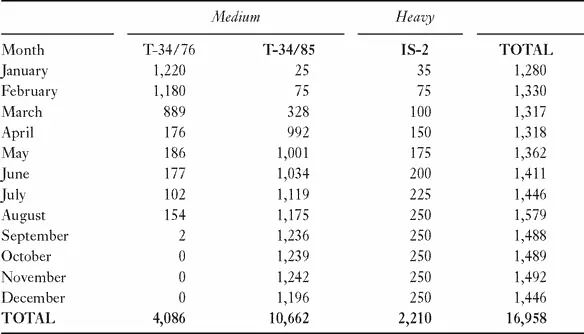
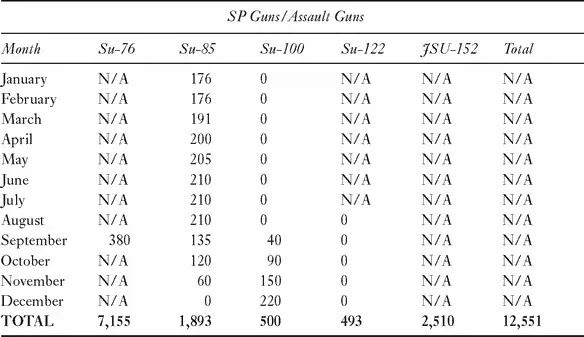
Key Industrial Decisions, 1944
• Production switched from the T-34/76 to the T-34/85 in April 1944 and T-34/76 production ceased entirely by September 1943.
• Chelyabinsk (ChTZ) ceased all T-34 production after March 1944 and switched entirely to IS-2 and ISU-152 production.
Plates
Bibliography
Интервал:
Закладка:
Похожие книги на «Tank Warfare on the Eastern Front, 1943-1945: Red Steamroller»
Представляем Вашему вниманию похожие книги на «Tank Warfare on the Eastern Front, 1943-1945: Red Steamroller» списком для выбора. Мы отобрали схожую по названию и смыслу литературу в надежде предоставить читателям больше вариантов отыскать новые, интересные, ещё непрочитанные произведения.
Обсуждение, отзывы о книге «Tank Warfare on the Eastern Front, 1943-1945: Red Steamroller» и просто собственные мнения читателей. Оставьте ваши комментарии, напишите, что Вы думаете о произведении, его смысле или главных героях. Укажите что конкретно понравилось, а что нет, и почему Вы так считаете.
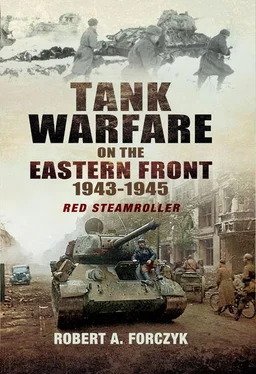







![John Stieber - Against the Odds - Survival on the Russian Front 1944-1945 [2nd Edition]](/books/405234/john-stieber-against-the-odds-survival-on-the-russian-front-1944-1945-2nd-edition-thumb.webp)


